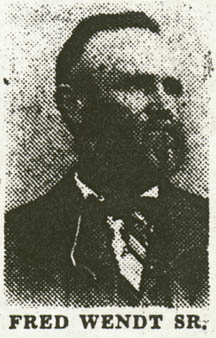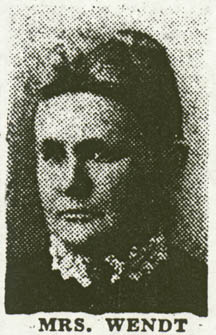Pioneering Was Rough When the
Wendts Came
Pioneering wasn't a
matter of the picturesque fringed buckskin shirts or the rumbling stage coaches
of "they went thet away" movies when Mr. and Mrs. Fred Wendt Sr. decided, back
in the early '60s to try their hand at farming in Alpine valley.
It was a matter of
grim determination, of hard work, of living in a log cabin, of riding horseback
over steep trails in an area where no roads existed--and of carving a living
out of the stubborn rocky hillsides of Julio Carrillo's Spanish grant rancho.
(an inset picture labeled "Fred Wendt SR.")
Comparatively recent
arrivals, in the '60s, from New Jersey, the German-born Wendts were accustomed
to hard work. It hadn't been a life of ease for Fred Wendt in the Old Country.
He had come to America in search of a freedom that was denied him under the
rule of the Kaisers.
When they first
arrived in Santa Rosa the Wendts bought a sizable piece of property in the
young town that had been laid out less than a decade before by Julio Carrillo,
Barney Hoen, Frederick Hahmann and William Harman. It was located at Hinton
Ave. and 3rd St. opposite the east side of the town square--on or near the site
of the present city hall and Sonoma County Jail.
IT WAS a good piece of
property, and one that would doubtless increase in value -- if one could hold
onto it long enough. But the parcels of town property of that day correspond in
a great degree to the rural homesites of today. They were large enough for a
family cow, and a garden. But after all they were in town, and the parcels
weren't big enough to produce a livelihood from the soil. Nor were there paying
jobs enough available in the young town to keep a young couple going -- even if
the husband was a husky, willing, all-around man. He could do carpentering. He
could build roads. He could cut wood. He could farm. He could handle almost any
job that came along. Only jobs weren't coming in fast enough.
So the Wendt property
was sold and the couple moved 10 miles away into the rugged, wooded country
called Alpine Valley. It was an area that offered possibilities for development
for a young man sturdy enough, and gritty enough, to tackle it.
Mr. Wendt pre-empted a
part of 500 acres and homesteaded the other part. A strongly built log cabin,
that may have been built under the direction of the original Spanish grantee,
stood on a part of the land.
"He moved it on
rollers to the other side of the line," his son, Leonard Wendt, recalled
recently,"and the family lived on it for 5 years."
The sturdy old
building, strongly built of squared logs, their ends dovetailed and pinned with
hardwood dowels to make rigid corners, still stands on the property -- a full
century old.
THERE WAS wood aplenty
to be cut on the 500 acres. Oak and manzanita and tall pines, and still taller
redwoods grew in profusion.
Fred Wendt fell to
with vim to clear the land for planting and to cut wood for the fires of fast
growing Santa Rosa.
Now 82 years old, his
son, Leonard, remembers the early days, both from his own childhood days and
from stories his parents told him.
"The road wasn't much
but a trail," he said. "They could get over it in a horse and cart. But when
better roads were needed to haul the wood and timber to town, the men of the
neighborhood got out with picks and shovels and dug them out by hand." (an
inset picture labeled "Mrs. Wendt")
Early in the
development of the area in which the Wendts were among the first to settle, the
gold fever that had brought them west in the first place gripped the pioneers.
They prospected in the hillslopes, even drifted a tunnel into one slope. But
gold eluded their efforts and they turned to the soil.
"I remember finding a
board with the name of one of the miners and the date of 1867 carved on it, way
back in the old tunnel when I was a youngster," Raford W. Leggett, grandson of
Mr. and Mrs. Wendt, recalled recently.
The tall, straight
grained redwoods, some of them of giant size (Leonard Wendt remembers one
fallen tree fully 20 feet in diameter on the nearby Downs property) supplied a
source of income, and some excellent building material in the area.
Many of the
outbuildings that followed the old squared log cabin on the ranch were built of
split material. "All the pickets in Rincon Valley and along Sonoma Ave. and the
rails and posts for fences were cut in Alpine Valley," said Leonard Wendt.
Wheat was the first
crop grown on the Wendt property. Fred Wendt cut it with a "cradle" attached on
his hand scythe, threshed it by hand and carried it on horseback to a grist
mill at the point where the Santa Rosa Brass Foundry now stands.
WHEN successful
experiments in Sonoma Valley proved the area excellent for growing wine grapes
of high quality, plantings of vines, largely the new Zinfandel variety, were
planted in the limestone hills of the Alpine Valley country.
"The whole vineyard
was grubbed out by hand," Leonard Wendt said. "In places the bedrock was right
on the surface. But it grew grapes -- fine grapes."
The vineyard on the
Wendt Ranch, now owned by R. B. Nawman and managed by Charley Head, is still
producing -- although in past seasons it has suffered considerably from deer
damage.
A few weeks ago at
height of the picking season, Mr. Head pointed out a triangular part of the
vineyard on which only the stumps remained. "Those were white grapes," he said.
"Deer like 'em."
Strangely enough, in
spite of increased numbers of hunters, deer damge is comparatively recent in
the hilly vineyard area, Leonard Wendt said:
"We never had any
protection but a 6-foot fence. Jackrabbits were considerable of a nuisance. But
there was very little deer damage when I was a youngster.
"Must be there are
more deer now than then," he mused. "In that section, anyway."
While many of the
relics of pioneer Santa Rosa have long since disappeared in the path of
progress and growth, the old log cabin that was very probably the first
habitation on the Wendt property, has been given a promise of long life.
Mr. Nawman plans to
restore it and keep it as a memento of the pioneer days.
|



